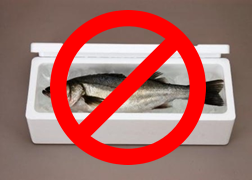
Going Zero Waste does not mean that you have to stop producing waste immediately. Many businesses achieve their Zero Waste goals by adopting a series of small steps that steadily reduce waste. Here’s an example.
“The Ritz-Carlton in San Francisco is working towards creating a culture of caring about waste. A zero waste mindset is part of that cultural shift towards steadily reducing waste. Managers and staff are engaged in alternative sourcing, innovative recycling techniques, and understanding what are best practices inside San Francisco’s waste management framework,” explains James Bernard, who works with clients from our Great Forest San Francisco office.
As a result, The Ritz-Carlton has made changes that have helped to reduce waste and increase recycling. Below, James shares 3 steps they have taken.
1) A Fishy Problem

Did you know that fish used to be shipped to restaurants in waxed boxes filled with ice instead of in EPS or extruded polystyrene foam (commonly known as the trademarked term Styrofoam) along with cold packs? The change to foam was to lower shipping weight and associated costs. The problem is that EPS foam is hard to recycle and lasts 500 years in the landfill, and cold packs are not recyclable.
When James sat down with The Ritz-Carlton’s Chef Michael Rotondo to discuss the problem of how to properly handle all those foam boxes (so they can be repurposed by Recology SF and not take up precious space in the trash steam), the conversation turned to how fish used to be shipped in the past. This prompted Chef Rotondo to call the hotel’s main West Coast fish supplier to request an end to foam boxes. Now fish arrives at The Ritz-Carlton in San Francisco in compostable waxed boxes with ice. It’s one way the hotel is reducing waste, and moving towards Zero Waste.
We learned of a similar story about food sourcing when Great Forest helped to judge the inaugural HANYC Sustainability Awards in 2014. The culinary director at the Waldorf Astoria in New York started ordering pineapples without heads because they were smaller. Eight pieces of headless pineapples could fit in each shipping carton instead of six regular pineapples. The hotel’s kitchen reported that it was able to reduce its fresh waste by 1.1 ton throughout the year.
2) Plastic in Plastic
When James explained to the pastry staff at The Ritz-Calton that clean, dry film plastic, including all the overwrap pastry operations use, could be recycled in San Francisco if they followed a simple 3 step process, the entire crew embraced the idea.
The process involves placing plastic film and wrap into a plastic bag, and then knotting it up when the plastic bag of plastic reaches size of a soccer ball. James demonstrated the technique to kitchen staff, and provided instructional signs. Today, the pastry crew regularly makes multiple bags daily for recycling and new members of the pastry team are introduced to the process. That’s a lot of plastic diverted from the landfill.
3) Getting Ahead of the Regulatory Curve on Single-Use Plastics

Starting with former Executive Chef Jason Rea, The Ritz-Carlton began providing reusable metal and compostable paper straws, wooden skewers and stirring sticks, and using compostable cups along with a water dispenser in the hotel lobby. These procurement actions placed the hotel in compliance well ahead of the single-use plastic ban ordinance that took effect in San Francisco on July 1, 2019. The ordinance requires all straws, stirring sticks, toothpicks, beverage plugs, and cocktail sticks to be plastic-free (eg: paper, bamboo, wood, metal, or fiber).
